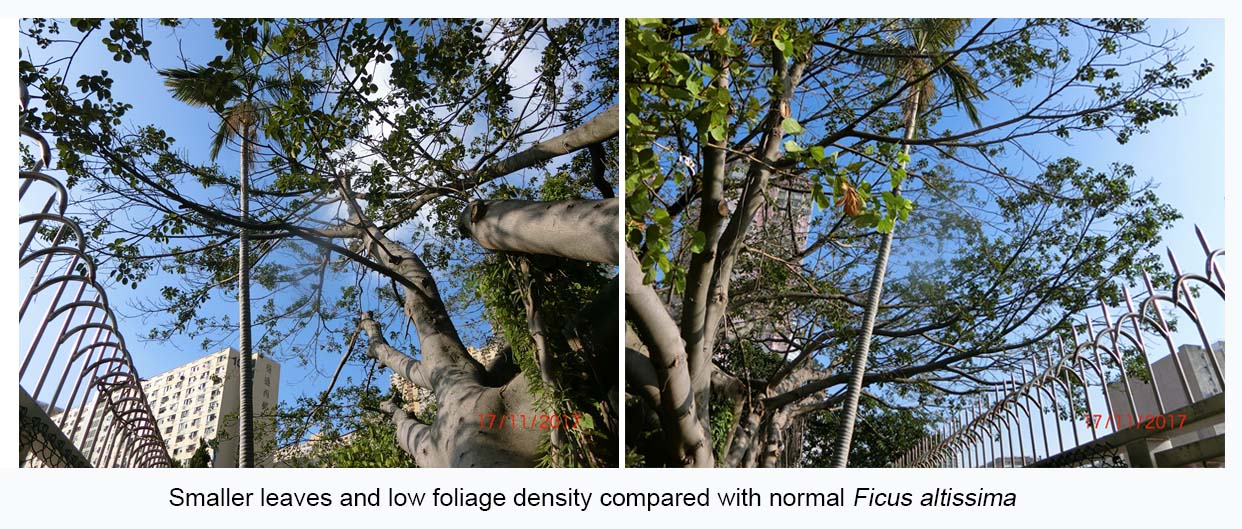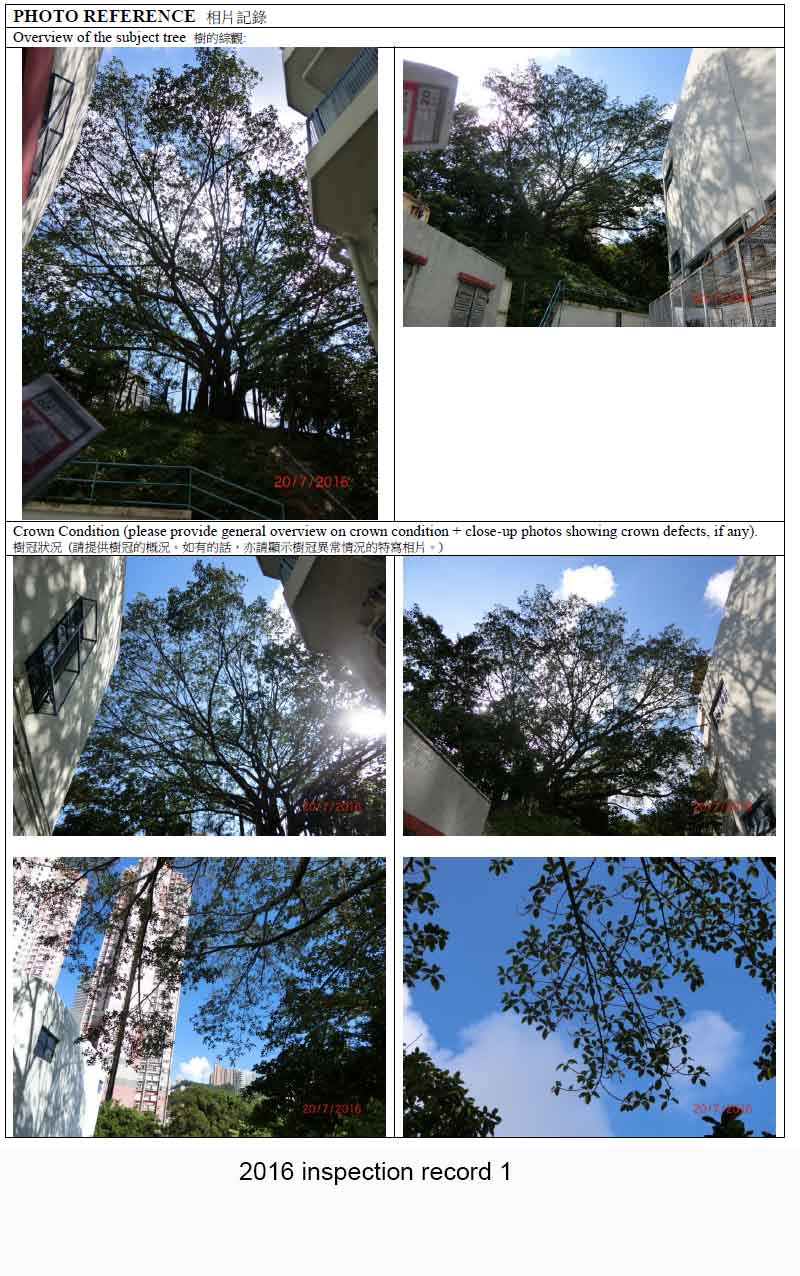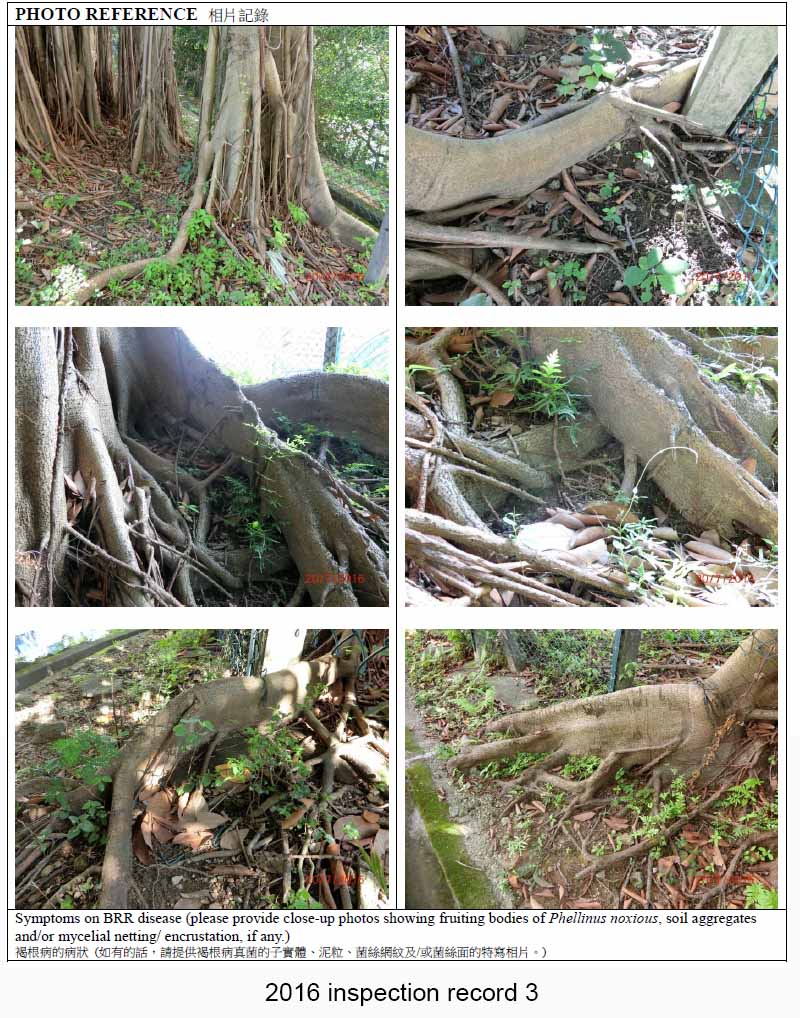1. Tree species and size
The assessed tree was a mature Ficus altissima 高山榕(雞榕). The tree had 2000mm diameter at breast height (measured 1.3mabove ground), 1 no. of trunk. Height was 14m and crown spread was 18m. This tree was registered to Old Valuable Tree (OVT), a sensitive tree.
2. Target and location
The site was a college in Kwai Chung HongKong. Frequently use area by students, teachers and parent. The tree was located at vegetated slope nearby school facilities (building) and slope access. Frequently students and staffs might passed through. The occupation of this area by students and staffs ‘Targets’ as well as the proximity of pedestrians and building bring a high probability of risk. The existing target situation is summarized in below table 2.1:
Table 2.1 Existing target situation:
|
Target
existing (Y/N) | Target removable(Y/N) | Site use restricted(Y/N) | Frequency of use |
| Y | N | N | High |
The existing Targets cannot be removed from the pathway or be restricted in their access. Tree Risk Assessment on an Area Basis defines a high use area as having high risk and is considered under Category 1.
3. General Condition
Sparse foliage density, leaves color was normal and leave size was smaller than normal. Poor tree vigor without leaning, Crown load was fair with medium live crown ratio. 50% dieback and severe dead branches were observed. Co-dominant branches and trunks were observed. Climber Mikania sp. was found.
4.Tree Defects
Severe dead branches and hangers indicated the tree was stressful. Heavy laternal limb and decay were observed in branches. This tree was confirmed Brown Root Rot Disease (BRRD) infected. Symptomson BRR disease fruiting bodies of Phellinus noxious, Mycelial encrustation was found. Exposed root and root rot were obvious. Moderate restricted root were conflicted by drainage, retaining structure and fences.
4. Site Condition
The tree was planted in 1m area with sandy soil. Tree emerged the canopy and exposed to prevailing wind.
5. Mitigation Measure
The tree was recommended to be removed and complied with protocol or removal BRRD trees and stumps ( refer to
[Citation 3] GUIDELINES ON BROWN ROOT ROT DISEASE, https://www.greening.gov.hk/filemanager/content/pdf/knowledge_database/Guidelines_on_Brown_Root_Rot_Disease(version_for_the_general_public)EN.pdf ). This method statement has covered the procedures of tree and stump removal works, backfilling and covering up the remaining tree pit as well as the measures to control the spread of the disease during the course of works. Application of fungicide to inhibit the spread of Phellinus noxius. Site check, soil test and reinspect nearby trees within 3 months. Mikania sp. and vegetation at root collar were proposed to clear.
6. Conclusion
The tree was confirmed with BRRD infection 13/10/2016. Phellinus noxius was a pathogenic fungus with strong virulence causing a white simultaneous rot on the roots and root collars. Structural of whole became unstable as internal decay. The symptoms inclueded smaller size of foliage than normal Ficus altissima. Furthermore, leaves shedding, brown color, these signs were the result of impair water transportation function of the vascular system. Health declining, foliage density was reduced and no sign of recovery observed. During this inspection, dieback twigs were observed and the severity was comparable to the last inspection. Root rot on one of the root was comparable to the last inspection. Area of mycelial encrustation was comparable to that of the last inspection, the tree health remained poor.
Recently, there is no direct remedy to cure the BRRD, removal of the infected tree is an effective way to control the spread of Phellinus noxius and mitigate the risk to properties and lives. The precautionary measure should be carried out during removal of the tree, such as disinfection of soil and dump the infected stumps properly.
In this case, the advanced technology of treating BRRD is needed. Government should support scientists to develop a new cure method. And cooperate with universities and international institutes to invent new medicine and study on BRRD. BRRD is a common disease to harm our trees which could damage the root system and cause the tree windthrow and collapsed. If get the cure method, the risk of tree failure would be reduced.
7. Tree photos


Ficus altissima needed a lot of space for their growth and anchor to ground.







8. Tree plan

Appendix 1: Method statement of trees and stumps removal for brown root rot infected site [Citation 3]
In order to prevent further spreading and infection of brown root rot disease, tree removal and its subsequent disposal of diseased parts(i.e. woody stumps, roots systems, fruiting bodies, fine roots in soils, debris) follow by removal or sanitation of the soil medium is very important. Besides, removal of undergrowth within the drip line of the infected tree also necessary to avoid building up of BRR disease inoculum.
Removal procedure
[Citation 3]
- Equipment to be used under the operation shall include hand saws, chain saws, shovels. Sufficient equipment and manpower shall be provided throughout the whole operation to speed up the works and to meet the planned schedule;
- The works area shall be barricaded with warning tape and with signage at a prominent location to indicate the proposed period of works as well as details of works;
- Before the operation, all undergrowth within the tree drip line, stumps and trees found within the infected area as well as the subject tree shall be applied with fungicide. The application procedure and dosage shall follow the instruction of the manufacturer;
- Appropriate personal protective equipment (PPE) (e.g. rubber gloves, face mask, gogglesetc.) shall be used when the workers handle and apply fungicide;
- A sterilization zone shall be set up and maintained at the entrance of the siteat all time. All personnel must have their shoes and equipment clean thoroughly with 1:49 bleach solution or 70% alcohol before leaving the site area;
- Before the commencement of tree removal operation, undergrowth such as shrubs within the drip line of the infected tree shall be removed first;
- Pruning works shall be carried out branch by branch and section by section;
- Pruning works shall firstly perform starting from the upper and outermost branches then the main trunk. Until the main trunk has cut to below2m from ground level, the tree will be cut by using notch and back cut method. The tree will then be allowed to freefall to the drop zone. The stump shall becut as close to the ground as practical;
- Further cuts shall be made at root flare as far from the tree stump as possible by the hammer drill, chain saw or handsaw which found to be applicable and appropriate at different excavation depth. As a general guideline, majority of the wood mass directly down below the stump shall be completely removed (i.e. with a depth of 500mm minimum);
- The excavated materials like tree stump, soil medium, roots and debris shall be disposed into plastic bag in-situ and sprayed with fungicide to prevent accidental dissemination of contaminated soil/infected tissues to the surrounding environment during delivery. Rolling of dug materials are prohibited;
- Fungicide shall be applied to the excavated pit and then properly cover with canvas sheets (fixed by U-pin into soil) as a temporary measure;
- The removed materials shall be disposed to the landfill directly;
- All equipment, tools and transportation equipment/vehicle (hopper) should be thoroughly disinfected using 1:49 bleach after the operation. The site shall be re-applied with fungicide. The excavated pit shall be backfilled with soil to match the finishing ground level and slope profile.
Citation
[1] https://www.greening.gov.hk/en/knowledge_database/brown_root.html [accessed on 14/12/2018]
[2] GUIDELINES FOR TREE RISK ASSESSMENT AND MANAGEMENT ARRANGEMENT
GREENING, LANDSCAPE AND TREE MANAGEMENT SECTION DEVELOPMENT BUREAUNOVEMBER 2015 (8th Edition)
[3] GUIDELINES ON BROWN ROOT ROT DISEASE
Issue Date: December 2012
TREE MANAGEMENT OFFICE GREENING, LANDSCAPE AND TREE MANAGEMENT SECTION DEVELOPMENT BUREAU THE GOVERNMENT OF THE HONG KONG SPECIAL ADMINSTRATIVE REGION
Click to access Guidelines_on_Brown_Root_Rot_Disease(version_for_the_general_public)EN.pdf